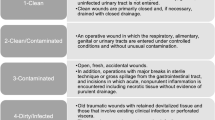Abstract
Objective
Despite the lack of evidence to support routine scheduled replacement of dialysis catheters (DCs) this practice continues to be widely used in many intensive care units (ICUs). This study evaluated whether additional risks of catheter-related infection (CRI) are incurred with a conservative attitude in critically ill cancer patients.
Design and setting
Prospective, observational study over a 14-month period in a 15-bed medicosurgical unit in a comprehensive cancer center.
Patients
Seventy-nine double-lumen DCs were evaluated in 47 patients. Incidence rates of infection per 1000 days of catheter use were examined over 7-day periods.
Measurements and results
The mean indwelling time was 6.9±5.5 days. Twelve DCs (15.2%) were removed for suspected CRI. Catheter-tip cultures remained negative in 74 cases (93.7%). Overall, one bacteremic CRI, two colonization episodes, and two contaminations were diagnosed, leading to DC colonization and DC-related bacteremia incidence rates of, respectively, 5.4 and 1.8 per 1000 days. When the catheter colonization rate was examined at 7-day intervals, the incidence rate was similar whatever the indwelling time: 5.8, 4.8, and 6.0 per 1000 days, respectively, for the 49 catheters left in place for 7 days or less, 8–14 days (21 DCs), and more than 14 days (9 DCs). The DC colonization incidence rate was similar to that of the 42 short-term catheters inserted during the same period in the same patients (5.9 per 1000 days).
Conclusions
The stable low risk for DC-related infections over time does not support the rationale for scheduled replacement, even in immunocompromised cancer patients.

Similar content being viewed by others
References
O’Grady NP, Alexander M, Dellinger EP, Gerberding JL, Heard SO, Maki DG, Masur H, McCormick RD, Mermel LA, Pearson ML, Raad II, Randolph A, Weinstein RA (2002) Healthcare Infection Control Practices Advisory Committee. Guidelines for the prevention of intravascular catheter-related infections. Infect Control Hosp Epidemiol 23:759–769
Rubinson L, Haponik EF, Wu AW, Diette GB (2003) Internists’ adherence to guidelines for prevention of intravascular catheter infections. JAMA 290:2802
Cyna AM, Hovenden JL, Lehmann A, Rajaseker K, Kalia P (1998) Routine replacement of central venous catheters: telephone survey of intensive care units in mainland Britain. BMJ 316:1944–1945
Souweine B, Traore O, Aublet-Cuvelier B, Badrikian L, Bret L, Sirot J, Gazuy N, Laveran H, Deteix P (1999) Dialysis and central venous catheter infections in critically ill patients: results of a prospective study. Crit Care Med 27:2394–2398
Wester JPJ, de Koning EJP, Geers ABM, Vincent HH, de Jongh BM, Tersmette M, Leusink JA (2002) Catheter replacement in continuous arteriovenous hemodiafiltration: the balance between infectious and mechanical complications. Crit Care Med 30:1261–1266
Blot F, Guiguet M, Nitenberg G, Leclercq B, Gachot B, Escudier B (1997) Prognostic factors for neutropenic patients in an intensive care unit. Respective roles of underlying malignancies and acute organ failures. Eur J Cancer 33:1031–1037
Le Gall JR, Lemeshow S, Saulnier F (1993) A new Simplified Acute Physiology Score (SAPS II) based on a European/North American multicenter study. JAMA 270:2957–2963
Knaus WA, Draper EA, Wagner DP, Zimmerman JE (1985) Prognosis in acute organ-system failure. Ann Surg 11:685–693
Raad II, Hohn DC, Gilbreath BJ, Suleiman N, Hill LA, Bruso PA, Marts K, Mansfield PF, Bodey GP (1994) Prevention of central venous catheter-related infections by using maximal sterile barrier precautions during insertion. Infect Control Hosp Epidemiol 15:231–238
Blot F, Chachaty E, Raynard B, Antoun S, Bourgain JL, Nitenberg G (2001) Mechanisms and risk factors for infection of pulmonary artery catheters and introducer sheaths in cancer patients admitted to an intensive care unit. J Hosp Infect 48:289–297
Brun-Buisson C, Abrouk F, Legrand P, Huet Y, Larabi S, Rapin M (1987) Diagnosis of central venous catheter-related sepsis. Critical level of quantitative tip cultures. Arch Intern Med 147:873–877
Blot F, Nitenberg G, Chachaty E,Raynard B,Germann N,Antoun S,Laplanche A,Brun-Buisson C, Tancrède C (1999) Diagnosis of catheter-related bacteraemia: a prospective comparison of the time to positivity of central vs. peripheral blood cultures. Lancet 354:1071–1077
Rijnders, B. J, W. E. Peetermans et al (2004) Watchful waiting versus immediate catheter removal in ICU patients with suspected catheter-related infection: a randomized trial. Intensive Care Med 30:1073–1080
Brun-Buisson, C (2004) Suspected central venous catheter-associated infection: can the catheter be safely retained? Intensive Care Med 30:1005–1007
Uldall PR, Merchant N, Woods F, Yarworski U, Vas S (1981) Changing subclavian haemodialysis cannulas to reduce infection. Lancet 8234:1373
Cook D, Randolph A et al (1997) Central venous catheter replacement strategies: a systematic review of the literature. Crit Care Med 25:1417–24
Pronovost PJ, Wu AW, Sexton JB (2004) Acute decompensation after removing a central line: practical approaches to increasing safety in the intensive care unit. Ann Intern Med 140:1025–1033
Nitenberg G, Blot F (2004) Diagnosis of catheter-related infections. In: O’ Grady, Pittet (eds) Catheter-related infections in the critically ill, 2nd edn. Kluwer, Boston, pp 59–76
Acknowledgements
The authors thank Ms L. Saint-Ange for editing, and the following nurses for their care and attention during their daily participation in this work: M. Minet (head nurse), M. Courchinoux-Nasri, I. Rousseau, V. Marchand, N. Torri-Piqueras, E. Moulon, C. Briant-Monplaisir, E. Lenoir-Fleury, and their colleagues.
Author information
Authors and Affiliations
Corresponding author
Rights and permissions
About this article
Cite this article
Harb, A., Estphan, G., Nitenberg, G. et al. Indwelling time and risk of infection of dialysis catheters in critically ill cancer patients. Intensive Care Med 31, 812–817 (2005). https://doi.org/10.1007/s00134-005-2621-5
Received:
Accepted:
Published:
Issue Date:
DOI: https://doi.org/10.1007/s00134-005-2621-5




